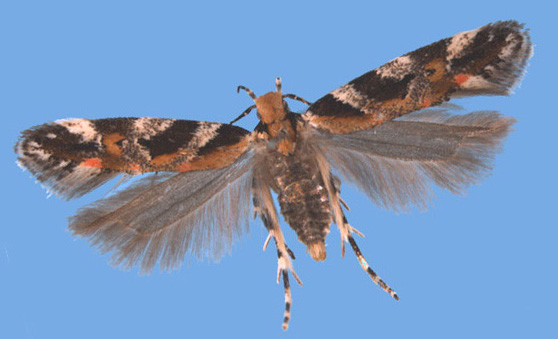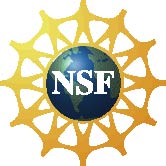Gelechiidae
by Sangmi Lee
Gelechiidae (Lepidoptera: Gelechioidea) is one of the largest families of microlepidoptera and includes more than 4,600 described species belonging to about 500 genera in the world (Hodges, 1999). Approximately 1,500 species occur in the Palearctic Region (Piskunov, 1990), and about 630 species occur in the Nearctic Region (Hodges, 1983). A large number of species are also present in the Oriental, Neotropical, Ethiopian, and Australian Regions (Becker, 1984; Common, 1990; Janse, 1958–1963;Heppner, 1991; Nielsen and Common, 1991;Park, 1992; Vári and Kroon, 1986).
Gelechiidae is similar to other gelechioid families in that its members have a scaled proboscis and strongly recurved labial palpus. Gelechiidae differ from other gelechioid families by having a combination of the following characters: 1) hindwing subrectangular to trapezoidal with sinuous or concave termen and prominent apex, 2) forewing lanceolate to elongate–ovate with CuP absent, 3) the retinaculum of the wing–coupling mechanism on the radial vein of the female forewing, 4) labial palpus long, second segment often with ventral brush, third segment long, acute, rarely with short dorsal brush of rough scales, 5) male gnathos forming a pair of lateral, articulated, symmetrical sclerites with an articulated, mesial hook (Hodges, 1986, 1999).
The first species of Gelechiidae were assigned to Phalaena (Tinea) by Linnaeus (1758), [Denis and Schiffermüller] (1775), Fabricius (1775), and other early workers. Subsequent descriptions of genera in the early 19th century included those of Billberg (1820) (Athrips), Hübner ([1825]) (Aristotelia, Brachmia, Chrysoesthia, Chionodes, Dichomeris, Gelechia, Hypatima, Mesophleps, Nothris, and Sophronia), Haworth (1828) (Chelaria, now a junior synonym of Hypatima, and Recurvaria), Curtis (1827) (Anacampsis), Treitschke (1833) (Lita, now Prolita), and Zeller (1839) (Megacraspedus, Anarsia, and Metzneria).
Stainton (1854) named the family “Gelechidae” to include Gelechia and 24 other genera occurring in Great Britain based on their possession of recurved labial palpus and broad posterior wings. The combined councils of the Oxford University Entomological Society and the Cambridge Entomological Society emended Stainton’s incorrect formation of the family name to Gelechiidae in An Accentuated List of the British Lepidoptera, with Hints on the Derivation of the Names, 1858.
Of the 25 genera originally included in Gelechiidae by Stainton, only five of them are available names now: Gelechia, Chelaria, Anarsia, Nothris, and Sophronia. The remaining genera have been transferred to other families. Of the 102 species assigned by Stainton to these five genera, 95 were assigned to Gelechia. Heinemann (1870) tried to make Gelechia a more natural group by erecting separate genera for species with slight modifications of wing structure and palpal characters. However, the definition of Gelechia continued to be difficult because ofthe absence of striking differences in the characters used by Heinemann; consequently, a large number of unrelated species were left in the genus. Chambers (1872c) and Spuler (1910) further supported the concept of Gelechia as an unnatural genus.
The use of genitalia for defining taxa, beginning with Pierce and Metcalfe (1935) and continued by Busck (1939), resulted in a more natural classification for many species. Pierce and Metcalfe restricted British Gelechia to eight species out of the 31 included by Meyrick. Busck (1939) combinedgenital characters with characters of wing venation and labial palpus to resurrect genera placed in synonymy with Gelechia by Meyrick and to describe seven new genera for North American and European species previously assigned to Gelechia. Gozmany (1955) examined the Hungarian Gelechia, and divided some 40 species among ten genera. Janse (1949–1954, 1958–1963) revised the South African Gelechiidae and reduced the number of species in Gelechia from 62 to 10, transferring the rest to existing or new genera.
Various family–group names have been proposed for taxa associated with Gelechiidae, including those of Bruand ([1851]) (Anacampsidae), Hampson (1918) (Dichomeridae), Meyrick (1926) (Anomologinae), Heslop (1938) (Aristoteliinae, Brachmiinae, and Chelariinae), Le Marchand (1947) (Apatetrinae, Autostichinae, and Lecithocerinae), Povoloný (1964) (Gnorimoschemini), and Piskunov (1973) (Teleiodini). Different workers have ranked these names as tribes, subfamilies, or families.
Meyrick (1925) proposed the first suprageneric classification of the Gelechiidae, dividing the family into nine genus–groups based primarily on wing venation. Sattler (1973) divided Meyrick’s genus–group names among nine subfamilies of Gelechiidae and three other families of Gelechioidea. Hodges (1983) recognized six subfamilies in America north of Mexico, and these subsequently were reduced to three subfamilies (Gelechiinae, Dichomeridinae, and Pexicopiinae) defined by the form of theabdominal support structure on the second sternum (Hodges, 1986). The comprehensive treatment of the European fauna by Karsholt and Riedl (1996) followed the subfamily classification of Hodges, but seven tribes were recognized in the Gelechiinae: Apatetrini, Anomologini, Teleiodini, Gelechiini, Gnorimoschemini, Anacampsini, and Chelariini. Recently, Hodges (1999) added the subfamily Physoptilinae, which occurs in the Oriental and Australian Regions. Although Hodges (1999) did not recognize tribes of Gelechiinae, he noted that there were several different male genital types typified by eight genera.
The Gelechiidae encompasses all feeding strategies known for Lepidoptera except exposed feeding and fungivory. These include scavenging, insect predation, lichen feeding, gall forming, leaf mining, seed mining, leaf tying, leaf rolling, stem boring, flower boring and case-making. Plant hosts include species in 108 families (see HOSTS - The Hostplants and Caterpillars Database" http://flood.nhm.ac.uk.cgi-bin/perth/hosts/index.dsml). Primary hosts of Gelechiidae in the Northern Hemisphere include (in decreasing order): Fabaceae, Asteraceae, Fagaceae, Rosaceae, Betulaceae/Salicaceae, Pinaceae, Solanaceae. Asteraceae are used most commonly by species of Dichomeridinae and Gelechiinae (Gelechiini, Anomologini, and Anacampsini) and Pinaceae hosts are concentrated within species of Gelechiinae (Teleiodini - 37 of 49 records) with independent evolution of this host preference in Gelechiini and Dichomeridinae. In the Southern Hemisphere primary hosts include species in Fabaceae, Euphorbiacee, Rubiaceae, Sapindaceae, Myrtaceae, and Combretaceae.
Most species are univoltine in the temperate Nearctic region, but many in southern latitudes have two or more broods per year. Among the various species, hibernation may occur in egg, larval or pupal stages (Hodges, 1986; 1999). Most adult species fly at dusk or during the night, when they may be collected at light. A few are predominately diurnal. For example. many Neotropical Anacampsinae are diurnal and walk or rest on upper surface leaves and the Nearctic Strobisia iridipenella is often collected in malaise traps during the day. During the day most species remain concealed, but some can be found on tree-trunks, flowers or seedheads (Bland et al., 2002).




